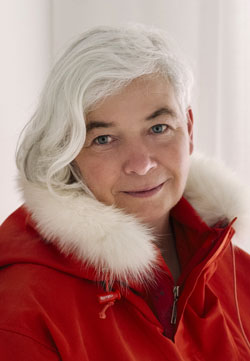Dorthe Dahl Jensen appointed Canada Excellence Research Chair at the University of Manitoba
Dorthe Dahl Jensen, Professor at Physics of Ice, Climate and Earth at the Niels Bohr Institute, University of Copenhagen, has been appointed Canada Excellence Research Chair at the University of Manitoba in Canada. Her attachment to the Niels Bohr Institute is still in place, and in the future she will be able to combine the two, to the benefit of both. They complement one another very well and the research field of the Canadian group is, in many ways, a continuation of Dorthe Dahl Jensen’s work. Dorthe Dahl Jensen assumed the position on 1. December last year and the Canadian Minister of Science and Sport, Kirsty Duncan, announced her appointment on 17. April.
From the inland ice sheet to the sea
The research section in Manitoba, Winnipeg, is a great capacity in research in sea ice and its development, as well as the chemical composition of sea water. It is the question of the fresh water interface or the addition of fresh water into the sea, which occupies Dorthe Dahl Jensen. How much fresh water pours into the sea and what the implications are for marine life in the sea, are some of the central issues for the research group, Dorthe Dahl Jensen will be joining in Canada. It ties things together. “It is my vision, with my former work with the ice flows and both my Danish grants, AP Møller and Villum, to understand the role of the ice flows in the climate system and understand how they contribute to the rise in sea water levels. Joining the Canadian programme means I can follow the ice all the way from the summit of the ice sheet to the sea”.

Our knowledge on the ice flow represents the greatest uncertainty in the assessment of sea level rise we possess pt. We still don’t know the processes determining the ice flow to an extent that allows us to model them. This means it still isn’t possible to forecast a development in sea level rise based on our current knowledge. For obvious reasons it is important to be able to make predictions of the sea level, so joining the insights from the research programs Dorthe Dahl Jensen is involved in, both at the Niels Bohr Institute and the ones she will be joining at the University of Manitoba, will be extremely relevant. Part of the plan is to enhance collaboration between the two groups of researchers, exchange PhD students, make programs for masters students, have researchers at the senior level do sabbaticals in both Copenhagen and Manitoba etc.
Plenty of projects both in Denmark and Canada
Several projects are under way, says Dorthe Dahl Jensen. Upernavik in the north east of Greenland has three glaciers, and they are behaving very differently, even though they are situated in the same area. This phenomenon must be studied. Upernavik has an airport so it is easily accessible. There isn’t a lot of ice in front of the glaciers, so a project to examine the situation at the very edge of the ice flow is possible. In Axel Heilberg’s Land in Canada an ice core drilling is projected, which can give us information on the sea ice distribution in pre historic time. A way to also create tools for forecasting the future development of the sea ice.
As if this was not enough, Dorthe Dahl Jensen is PI, Primary Investigator, on the BEYOND EPICA project. This project aims to drill an ice core going back in time 1.5 million years. It will be drilled in Antarctica and a location has been found. “We want to try and understand why we have a cycle of ice ages and interglacials changing periods and we need to measure the greenhouse gasses further back in time than we can as it is”, says Dorthe Dahl Jensen. “We hope for Denmark to be able to play an important role in the project. Thomas Blunier from Physics of Ice, Climate and Earth at the Niels Bohr Institute is heading one of the consortiums under the project, examining greenhouse gasses, caught in the 1.5 million years old ice. So we already have a great capacity working in this field, who is able to do research in the period we still don’t have data on. We can only see approximately 800.000 years back in time, with the ice cores we have now”.
Dorthe Dahl Jensen plans on spending two months a year in Canada, one in the spring and one in the autumn, but she will be working continuously on the Canadian projects. It seemed the easy way to go about it to have a permanent residence, a small terraced house, so other researchers can come calling – for easier exchange of scientific ideas and thoughts.
